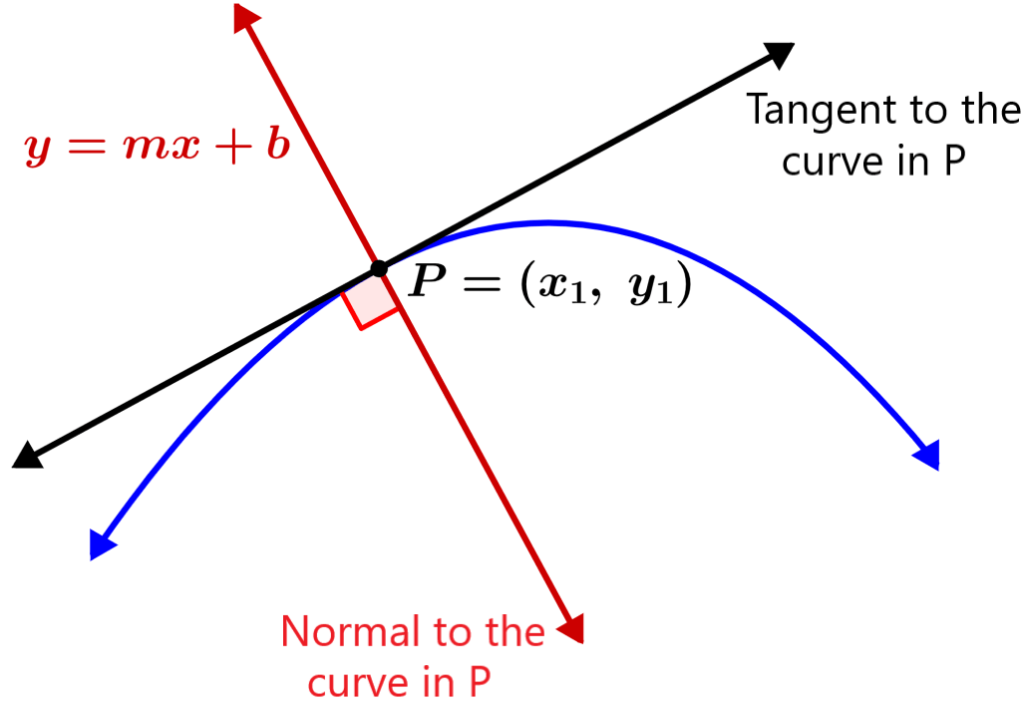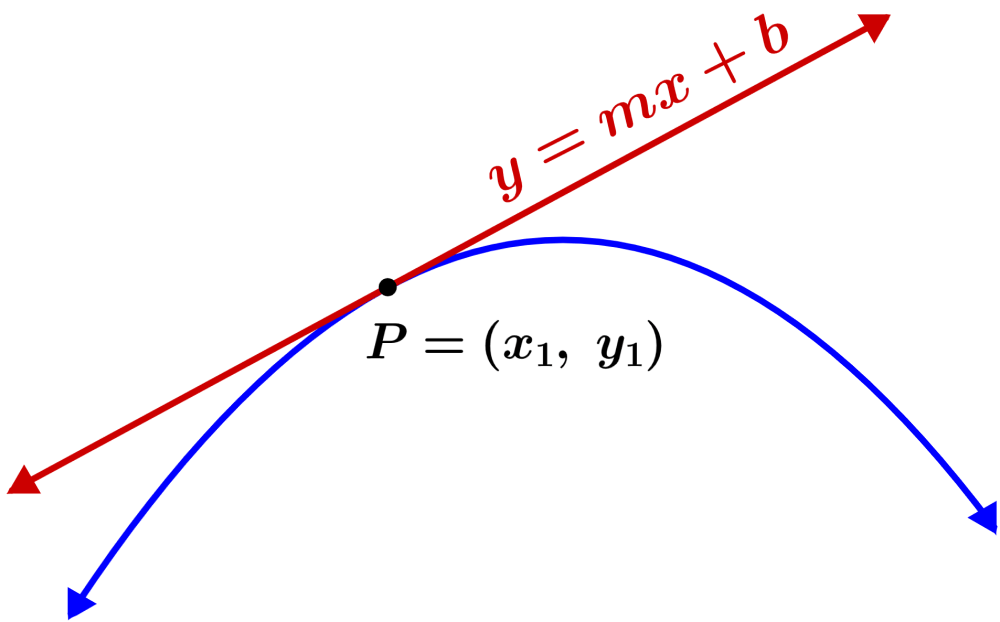The tangent line to a curve is found using the form y=mx+b, where m is the slope of the line and b is the y-intercept. In turn, the slope is calculated using the derivative of the function. Similarly, we find the equation of the normal line considering that its slope is a negative reciprocal of the tangent line.
Here, we will learn about tangent and normal lines to a curve. We will learn how to obtain their equations and we will solve some practice examples.
CALCULUS

Relevant for…
Learning to find the equations of the tangent and normal lines to a curve.
CALCULUS

Relevant for…
Learning to find the equations of the tangent and normal lines to a curve.
How to find the equation of the tangent line to a curve?
The equation of the tangent line to a curve can be found if we know the function that produces the curve and the coordinates of the tangential point, as seen in the following diagram:

Then, we can use the slope-intercept form of a linear function, $latex y=mx+b$, where m is the slope of the line and b is the y-intercept.
If we know the equation of the curve and the coordinates of the point $latex P=(x_{1},~y_{1})$, we can follow these steps:
Step 1: Find the derivative of the function that produces the curve.
Step 2: Determine the slope of the tangent line using the derivative.
Since we know the tangential point $latex (x_{1},~y_{1})$, we can evaluate the derivative of the function at the x-coordinate of the point to get the slope. That is, we have $latex m=f'(x_{1})$.
Step 3: Find the value of b using the equation $latex y=mx+b$ with the value of the slope found in step 2.
We can achieve this by using the coordinates $latex (x_{1},~y_{1})$ of the given point in the form $latex y=mx+b$ and solving for b. That is, we have $latex y_{1}=mx_{1}=b$.
Step 4: Use the values of m and b in the form $latex y=mx+b$ to obtain the equation of the tangent line.
How to find the equation of the normal line to a curve?
The equation of the normal line to a curve is found in a similar way as we find the equation of the tangent line. The difference is that we consider the normal line to be perpendicular to the tangent line, as shown in the diagram:

Then, the slope of the normal line is equal to the negative reciprocal of the tangent line. That is, if the slope of the tangent is $latex m$, then the slope of the normal is equal to $latex -\frac{1}{m}$.
If we know the function that represents the curve and the coordinates of the point $latex (x_{1},~y_{1})$, we can follow these steps:
Step 1: Determine the derivative of the function.
Step 2: Use the derivative to find the slope of the tangent line to the curve at the point $latex (x_{1},~y_{1})$. For this, we have $latex m_{1}=f'(x_{1})$.
Step 3: Determine the slope of the normal line using the slope from step 2. The slope of the normal line is equal to $latex m=-\frac{1}{m_{1}}$, where $latex m_{1}$ is the slope of the tangent line.
Step 4: Using the form $latex y=mx+b$ and the slope from step 3, determine the value of b. For this, we use the coordinates of the point $latex (x_{1},~y_{1})$. That is, we have $latex y_{1}=mx_{1}=b$.
Step 5: We substitute the values of m and b in the form $latex y=mx+b$ to obtain the equation of the normal line.
Tangent line and the normal line to a curve – Examples with answers
EXAMPLE 1
If we have the function $latex f(x)=3x^2-3x$, find the equation of the tangent line at the point (1, 3).
Solution
Step 1: We start by finding the derivative of the function that represents the curve:
$latex f(x)=3x^2-3x$
$latex f'(x)=6x-3$
Step 2: We evaluate $latex f'(1)$ to find the slope of the tangent line at the point (1, 3):
$latex m=f'(1)=6(1)-3$
$latex m=3$
Step 3: The slope from step 2 gives us the equation $latex y=3x+b$. Then, we use the point (1, 3) in the equation to find the value of b:
$latex y=3x+b$
$latex 3=3(1)+b$
$latex b=0$
Step 4: The equation of the tangent line at the point (1, 3) is $latex y=3x$.
EXAMPLE 2
We have the function $latex f(x)=x^2$. Determine the equation of the normal line at the point P=(3, 2).
Solution
Step 1: The derivative of the function is:
$latex f(x)=x^2$
$latex f'(x)=2x$
Step 2: We evaluate $latex f'(3)$ to find the slope of the tangent line at the point (3, 2). Then, we have:
$latex m_{1}=f'(3)=2(3)$
$latex m_{1}=6$
Step 3: We use the slope of the tangent line to find the slope of the normal line, which is $latex m=-\frac{1}{6}$.
Step 4: Using the slope of the normal, we have the equation $latex y=-\frac{1}{6}x+b$. Now, we use the point (3, 2) in the equation to determine the value of b:
$latex y=-\frac{1}{6}x+b$
$latex 2=-\frac{1}{6}(3)+b$
$latex b=\frac{5}{2}$
Step 5: The equation of the normal line at the point (3, 2) is $latex y=-\frac{1}{6}x+\frac{5}{2}$.
EXAMPLE 3
What is the equation of the tangent line to the function $latex f(x) = -x^{-2}+\sqrt{x}$ at the point (1, 3)?
Solution
Step 1: To find the derivative, we use the laws of exponents to write the square root as a numerical exponent:
$latex f(x)=-x^{-2}+x^{\frac{1}{2}}$
$$f'(x)=2x^{-3}+\frac{1}{2}x^{-\frac{1}{2}}$$
$$f'(x)=\frac{2}{x^3}+\frac{1}{2\sqrt{x}}$$
Step 2: Using the derivative, we evaluate $latex f'(1)$ to find the slope of the tangent line at (1, 3):
$$m=f'(1)=\frac{2}{(1)^3}+\frac{1}{2\sqrt{1}}$$
$latex =2+\frac{1}{2}$
$latex m=\frac{5}{2}$
Step 3: The slope from step 2 gives us the equation $latex y=\frac{5}{2}x+b$. Then, we use the point (1, 3) in the equation to find the value of b:
$$y=\frac{5}{2}x+b$$
$$3=\frac{5}{2}(1)+b$$
$latex b=\frac{1}{2}$
Step 4: The equation of the tangent line at the point (1, 3) is $latex y=\frac{5}{2}x+\frac{1}{2}$.
EXAMPLE 4
If we have the function $latex f(x)=x^3+\frac{8}{x}$, determine the equation of the normal line at the point (2, -2).
Solution
Step 1: We use the laws of exponents to write the function with only numerical exponents and thus calculate its derivative:
$latex f(x)=x^3+8x^{-1}$
$latex f'(x)=x^2-8x^{-2}$
$latex f'(x)=x^2-\frac{8}{x^2}$
Step 2: The slope of the tangent at (2, 4) is found by evaluating $latex f'(2)$:
$latex m_{1}=f'(2)=(2)^2-\frac{8}{2^2}$
$latex =4-2$
$latex m_{1}=2$
Step 3: We use the slope from step 2 to determine the slope of the normal and we have $latex m=-\frac{1}{2}$.
Step 4: Using the slope from step 3, we have the equation $latex y=-\frac{1}{2}x+b$. Now, we use the point (2, -2) in the equation to find the value of b:
$latex y=-\frac{1}{2}x+b$
$latex -2=-\frac{1}{2}(2)+b$
$latex b=-1$
Step 5: The equation of the normal line at the point (2, 4) is $latex y=-\frac{1}{2}x-1$.
EXAMPLE 5
If we have the function $latex f(x)=x^2-3x+1$, find the equation of the tangent line at the point where the curve intersects the y-axis.
Solution
Step 1: The derivative of the function is:
$latex f(x)=x^2-3x+1$
$latex f'(x)=2x-3$
Step 2: We don’t have the coordinates of the tangential point, but we do know that the line is tangent at the point where the curve intersects the y-axis.
When a function intersects the y-axis, the x-coordinates are equal to 0. Then, we have:
$latex y=x^2-3x+1$
$latex y=0^2-3(0)+1$
$latex y=1$
The tangential point is (0, 1). Now, we evaluate $latex f'(0)$ to find the slope of the tangent and we have:
$latex m=f'(0)=2(0)-3$
$latex m=-3$
Step 3: Using the slope from step 3, we have the equation $latex y=-3x+b$. Then, we use the point (0, 1) in the equation to find the value of b:
$latex y=-3x+b$
$latex 1=-3(0)+b$
$latex b=1$
Step 4: The equation of the tangent line at the point (0, 1) is $latex y=-3x+1$.
EXAMPLE 6
Find the normal line to the function $latex f(x)=\sin(x)-\cos(x)$ at the point (0, 1).
Solution
Step 1: The derivative of the given trigonometric function is:
$latex f(x)=\sin(x)-\cos(x)$
$latex f'(x)=\cos(x)+\sin(x)$
Step 2: We evaluate $latex f'(0)$ to find the slope of the tangent line at the point (0, 1):
$latex m=f'(0)=\cos(0)+\sin(0)$
$latex m_{1}=1+0$
$latex m_{1}=1$
Step 3: The slope of the normal line is equal to $latex m=-1$.
Step 4: Using the slope from step 3, we have the equation $latex y=-x+b$. So we use the point (0, 1) in the equation to find the value of b:
$latex y=-x+b$
$latex 1=-0+b$
$latex b=1$
Step 5: The equation of the normal line at the point (0, 1) is $latex y=-x+1$.
Tangent line and normal line to a curve – Practice problems
See also
Interested in learning more about equations of tangent and normal lines to functions? You can look at these pages:



